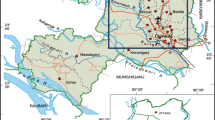Abstract
Fruits and vegetables grown under the impact of Armenia’s mining industry are widely sold in markets of adjacent towns. As the share of fruits and vegetables in Armenians’ diet is significant, the present study aims to assess the dietary exposure of potentially toxic trace elements through the intake of fruits and vegetables sold in Kapan town, located in the biggest mining region of Armenia. The concentrations of Cu, Mo, Ni, Cr, Pb, Zn, Hg, As, and Cd in 15 types of fruits and vegetables were determined. Non-carcinogenic and carcinogenic risks were assessed. Although the estimated daily intakes of trace elements for each studied food item did not exceed health-based guidelines values, in case of the combined consumption of fruits and vegetables estimated cumulative daily intakes exceeded reference doses for Cu and Mo. Moreover, carcinogenic risk for the majority of fruits and vegetables exceeded the EPA recommended risk level of 10−6, indicating adverse health effect to local population. The outcomes of this study can serve as a basis for further research that will consider many other exposure pathways (i.e., inhalation or dermal pathways) in order to ensure the safety of the residents living under the impact of mining industry.
Similar content being viewed by others
References
Khillare PS, Jyethi DS, Sarkar S (2012) Health risk assessment of polycyclic aromatic hydrocarbons and heavy metals via dietary intake of vegetables grown in the vicinity of thermal power plants. Food Chem Toxicol 50:1642–1652
Hall JN, Moore S, Harper SB, Lynch JW (2009) Global variability in fruit and vegetable consumption. Am J Prev Med 36(5):402–409
Zhu D, Wei Y, Zhao Y, Wang Q, Han J (2018) Heavy metal pollution and ecological risk assessment of the agriculture soil in Xunyang mining area, Shaanxi Province, northwestern China. Bull Environ Contam Toxicol:1–7
Lee S, Chung J, Lee YW (2018) Cu and Zn concentrations in seawater and marine sediments along Korean coasts from the perspective of antifouling agents. Bull Environ Contam Toxicol:1–6
Belyaeva OA (2012) Impact of mining enterprises of the city of Kapan on adjacent agroecosystems. Natural Sci 2:19
Pipoyan D, Beglaryan M, Costantini L, Molinari R, Merendino N (2018) Risk assessment of population exposure to toxic trace elements via consumption of vegetables and fruits grown in some mining areas of Armenia. Hum Ecol Risk Assess: An Int J 24(2):317–330
Saghatelyan A, Sahakyan L, Belyaeva O (2012) Polluted irrigation waters as a risk factor to public health. Chemistry J Moldova. General, Industrial Ecological Chemistry 7(2):84–88
WHO/FAO (2008) Dietary exposure assessment of chemicals in food. In: Annapolis. Maryland, USA http://apps.who.int/iris/bitstream/10665/44027/1/9789241597470_eng.pdf
US EPA (1997) Exposure factors handbook. In: EPA/600/P-95/002F. USA, Washington DC https://cfpub.epa.gov/ncea/risk/recordisplay.cfm?deid=12464
US EPA (1999) Screening level ecological risk assessment protocol for hazardous waste combustion facilities, appendix E: toxicity reference values. United States Environmental Protection Agency
Agency for Toxic Substances and Diseases Registry (ATSDR) (2004) Toxicological profile for copper. Update. Atlanta, GA: Agency for Toxic Substances and Diseases Registry, Centers for Disease Control. https://www.atsdr.cdc.gov/toxprofiles/tp.asp?id=206&tid=37
EFSA Panel on Contaminants in the Food Chain (CONTAM) (2010) Scientific opinion on lead in food. EFSA J 8(4):1570 http://www.efsa.europa.eu/en/efsajournal/pub/1570
EFSA Panel on Contaminants in the Food Chain (CONTAM) (2012) Scientific opinion on the risk for public health related to the presence of mercury and methylmercury in food. EFSA J 10(12):2985 https://www.efsa.europa.eu/en/efsajournal/pub/2985
EFSA Panel on Contaminants in the Food Chain (CONTAM) (2014) Scientific opinion on dietary reference values for chromium. EFSA J 12(10):3845 https://www.efsa.europa.eu/en/efsajournal/pub/3845
US EPA (1989) Cadmium; CASRN 7440-43-9. Washington DC, USA https://cfpub.epa.gov/ncea/iris2/chemicalLanding.cfm?substance_nmbr=141
US EPA (1991a) Arsenic, inorganic; CASRN 7440-38-2. Washington DC, USA https://cfpub.epa.gov/ncea/iris2/chemicalLanding.cfm?substance_nmbr=278
US EPA (1991b) Nickel, soluble salts; CASRN Various. Washington DC, USA https://cfpub.epa.gov/ncea/iris2/chemicalLanding.cfm?substance_nmbr=271
US EPA (1992) Molybdenum; CASRN 7439-98-7. Washington DC, USA https://cfpub.epa.gov/ncea/iris2/chemicalLanding.cfm?substance_nmbr=425
US EPA (2005) Zinc and compounds; CASRN 7440-66-6. Washington DC, USA https://cfpub.epa.gov/ncea/iris/iris_documents/documents/subst/0426_summary.pdf
Real MIH, Azam HM, Majed N (2017) Consumption of heavy metal contaminated foods and associated risks in Bangladesh. Environ Monit Assess 189(12):651
EC (2006) Regulation (EC) No. 1881/2006 of 19 December 2006 Setting maximum levels for certain contaminants in foodstuffs. Off J Eur Union 5:24. http://eur-lex.europa.eu/legal-content/EN/ALL/?uri=CELEX%3A32006R1881
FAO/WHO (1993) Food additives and contaminants. Joint FAO/WHO Food Standard Programme ALINORM 01/12A. Rome, Italy, pp 1–289
Joint FAO/WHO expert committee on food additives (JECFA) (2002) Limit test for heavy metals in food additive specifications: Explanatory note. http://www.fao.org/fileadmin/templates/agns/pdf/jecfa/2002-09- 10_Explanatory_note_Heavy_Metals.pdf
Qureshi AS, Hussain MI, Ismail S, Khan QM (2016) Evaluating heavy metal accumulation and potential health risks in vegetables irrigated with treated wastewater. Chemosphere 163:54–61
Ahmad J, Goni M (2010) Heavy metal contamination in water, soil, and vegetables of the industrial areas in Dhaka, Bangladesh. Environ Monit Assess 166(1–4):347–357
Cherfi A, Cherfi M, Maache-Rezzoug Z et al (2016) Risk assessment of heavy metals via consumption of vegetables collected from different supermarkets in La Rochelle, France. Environ Monit Assess 188:1–10
Tchounwou PB, Yedjou CG, Patlolla AK, Sutton DJ (2014) Heavy metal toxicity and the environment. Molecular Clinical Environ Toxicology 101:133–164
Acknowledgments
This study was made with the support of State Committee of Science, Ministry of Education and Science of Armenia.
Author information
Authors and Affiliations
Corresponding author
Ethics declarations
Conflict of Interest
The authors declare that they have no conflict of interest.
Rights and permissions
About this article
Cite this article
Pipoyan, D., Beglaryan, M., Stepanyan, S. et al. Dietary Exposure Assessment of Potentially Toxic Trace Elements in Fruits and Vegetables Sold in Town of Kapan, Armenia. Biol Trace Elem Res 190, 234–241 (2019). https://doi.org/10.1007/s12011-018-1522-8
Received:
Accepted:
Published:
Issue Date:
DOI: https://doi.org/10.1007/s12011-018-1522-8




